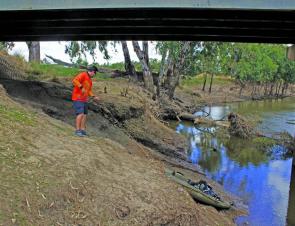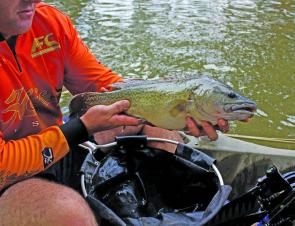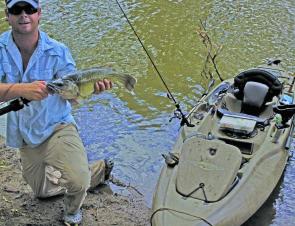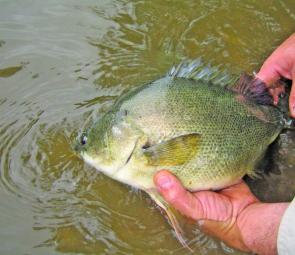No places suit a kayak fisher better that those skinny pieces of water that are totally inaccessible to boats and land-based options. Fishing kayaks were made for this water; they turn the inaccessible into the accessible and deliver fishing of a quality tough to match.
Over the past few years I have been chasing natives out of my Hobie in some small, snaggy creeks and I have refined a few techniques that I believe make fishing from a kayak or canoe a lot more successful.
There is a widespread belief that when yak fishing in tight, snaggy waters you should leave your second rod in the car because it’s far too difficult to run two rods. This is not necessarily the case.
Obviously, having two lures out the back of your kayak in narrow snags makes for some interesting kayaking, but it increases your chances of hooking up by 50%.
Sure, your snag rate increases and at times it can be ultra-frustrating, but there is a method I have refined over time that greatly reduces your frustration and still catches fish.
One of the keys to this technique is having a hands-free drive system. I fish from a Hobie Outback and have found its hands free performance to be a great fishing asset.
The tactic involves running a shallow lure only about 5m to 10m behind the yak. Once your lure is out, this rod goes into the rod holder.
The idea is that it will target the golden perch that, when active, like to sit in mid water around structure. You will only very rarely pick up a Murray cod on this rod because the big cod love to hug the bottom.
You can’t ‘work’ this lure through snags like you can when you’re holding a rod, so you tend to get a few more snags on this lure.
The most important thing is that it needs to be a shallow-running lure, something that gets down to about 2m to 3m. It will be sitting in the middle of the water column. Almost all of the golden perch I caught last summer were captured on this set-up.
Often when you talk to educated fishers about trolling lures they will speak of the need to actively fish lures.
By this they mean constantly making adjustments to the lure’s running depth so that it sits in the strike zone 1m off the bottom for as long as possible. This is done by lengthening or shortening the drop-back or lifting and lowering the rod tip.
This is how you fish your second rod. The idea is to run a much deeper-diving lure, generally of a larger profile, that can easily reach the strike zone.
By having this rod in your hand you are able to regularly adjust the lure’s running depth so that it is constantly sitting in that strike zone.
Patience is the key to mastering this technique. Sometimes it can seem like more trouble than it’s worth, but a large increase in catch rates is enough to warrant the occasional frustrating session.
As the water starts to cool off from Easter onwards and the golden perch begin to shut down, I quite often revert to actively trolling just one medium to large lure. The goldens aren’t nearly as active in colder water so it’s rare to find them sitting around mid-water structure then. So the logical decision is to target only the cod strike zone.
Snags are a big part of fishing for natives and if you actually want to catch fish it’s inevitable that you’re going to get snagged as well.
When I was starting out in the yak I found myself losing a few more lures than I should have, mainly because I wasn’t employing effective tactics in de-snagging my lures.
One of the most important things in de-snagging lures is having the right equipment.
I always carry a telescopic pole and a weighted retriever. This way I am able to assess each snag and employ the most appropriate method.
With good management and some patience you will not have too much trouble getting your lures back.
When you first realise your trolling lure has grabbed some immovable object you need to spin 180° straight away so you face the lure. Try not to loop around to the lure because this will increase your chance of wrapping the line around the snag, further complicating things.
Slowly make your way back towards the snag until you’re sitting right over it. Most of the time a couple of quick jerks with the rod are all that’s needed.
But every now and then the hooks sink right in so it’s important to have a telescopic pole or a weighted retriever that can be sent down to dislodge the lure.
I mostly use my weighted retriever in skinny rivers, only because I find it much more manageable in a kayak.
The most important thing to remember is not to panic – with patience almost all snagged lures are retrievable. Last season from hundreds of snags I managed to retrieve all but one of my lures, purely because I always took my time.
Casting lures allows you to probe every nook and cranny each piece of structure has to offer. But at times it can become quite frustrating, especially if you’re casting bigger lures and spinnerbaits.
The major problem I experience in my Hobie Outback is the effect that the ‘pull’ of the lure can have on your kayak. I can set myself up perfectly to launch a repeated attack on a piece of structure, only to find that after my third or fourth cast, the water resistance of the lure has actually started to move my kayak towards the target.
When fishing structure for natives it is important to put in as many casts as you can. Natives are territorial fish and quite often can be annoyed into striking a lure.
But with the lure pulling your kayak into the hot spot, it makes repeated casting nearly impossible.
A quick solution to this would be an anchor, right? Wrong! The problem with anchors in snaggy water is that they can be quite difficult to dislodge.
In a boat you can stand up and put your back into it, and you also have the buoyancy of the boat to counter your pulling power. In a kayak it is a lot different; you can’t stand up and you don’t have the buoyancy of a big boat to help lift the anchor free
After many hours of trial and error, my fishing partners and I have settled on a technique that allows us to maximise casting time in tight, snaggy waters.
It involves attaching a small spring-loaded clamp to a 1m to 2m piece of rope and attaching the rope near the cockpit of the kayak. When you come across a piece of structure you want to cast to, you just set your yak next to another piece of structure within casting distance and attach the spring loaded clamp to the structure so that it holds you in place while you pump as many casts as you want into the area. When you have pulled a fish or give up it’s just a matter of releasing the clamp and you’re free to go where you want, it is very quick and easy. Occasionally you won’t be able to find a piece of structure to clamp onto but in my experience it is very rare in tight snaggy waters.
Reads: 2642
The beauty of kayaks is that they can be launched just about anywhere.

Wagga Wagga angler Michael Kanck displays the rewards of keeping your lure in the strike zone. A well-conditioned 60cm trout cod.

The author with a solid fish taken while actively trolling his lure. Cod almost always like a lure that is constantly within 1m of the bottom.

An example of how to employ the trolling method.

Using the clamp to secure the kayak to make casts at a particular piece of structure.

This thumping 60cm golden perch was taken on the ‘unmanned’ rod. It was almost lost after wrapping itself around a snag, which meant the author had to beach the kayak and go swimming to untangle the beast.

Through the warmer months, golden perch will sit around mid-water structure. You can tangle with specimens like this without actively targeting bottom structure.




